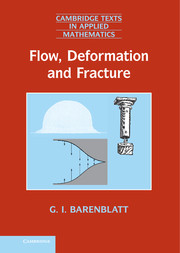 Flow, Deformation and Fracture
Flow, Deformation and Fracture Book contents
- Frontmatter
- Dedication
- Contents
- Foreword
- Preface
- Introduction
- 1 Idealized continuous media: the basic concepts
- 2 Dimensional analysis and physical similitude
- 3 The ideal incompressible fluid approximation: general concepts and relations
- 4 The ideal incompressible fluid approximation: analysis and applications
- 5 The linear elastic solid approximation. Basic equations and boundary value problems in the linear theory of elasticity
- 6 The linear elastic solid approximation. Applications: brittle and quasi-brittle fracture; strength of structures
- 7 The Newtonian viscous fluid approximation. General comments and basic relations
- 8 The Newtonian viscous fluid approximation. Applications: the boundary layer
- 9 Advanced similarity methods: complete and incomplete similarity
- 10 The ideal gas approximation. Sound waves; shock waves
- 11 Turbulence: generalities; scaling laws for shear flows
- 12 Turbulence: mathematical models of turbulent shear flows and of the local structure of turbulent flows at very large Reynolds numbers
- References
- Index
5 - The linear elastic solid approximation. Basic equations and boundary value problems in the linear theory of elasticity
Published online by Cambridge University Press: 05 June 2014
- Frontmatter
- Dedication
- Contents
- Foreword
- Preface
- Introduction
- 1 Idealized continuous media: the basic concepts
- 2 Dimensional analysis and physical similitude
- 3 The ideal incompressible fluid approximation: general concepts and relations
- 4 The ideal incompressible fluid approximation: analysis and applications
- 5 The linear elastic solid approximation. Basic equations and boundary value problems in the linear theory of elasticity
- 6 The linear elastic solid approximation. Applications: brittle and quasi-brittle fracture; strength of structures
- 7 The Newtonian viscous fluid approximation. General comments and basic relations
- 8 The Newtonian viscous fluid approximation. Applications: the boundary layer
- 9 Advanced similarity methods: complete and incomplete similarity
- 10 The ideal gas approximation. Sound waves; shock waves
- 11 Turbulence: generalities; scaling laws for shear flows
- 12 Turbulence: mathematical models of turbulent shear flows and of the local structure of turbulent flows at very large Reynolds numbers
- References
- Index
Summary
The mathematical theory of elasticity based on the idealization presented in this chapter is a remarkable classical branch of the mechanics of continua, which has advanced far in the more than 200 years it has been studied. In this chapter a concise presentation of the fundamentals of this theory will be given, bearing in mind readers who have not met it before, and it will also serve as a preparation for the next chapter, where we discuss the mathematical modeling of fracture phenomena, which nowadays is the principal area of attention.
The fundamental idealization
A crucially important property of a deformable solid continuum is that it is possible for it to possess non-trivial stress distributions even when the body is at rest, i.e. when the velocity is everywhere equal to zero.
The theory of elasticity as a science is older than fluid mechanics. Its basic law, which was developed to a fundamental model, was formulated by Robert Hooke more than 300 years ago, in the article Hooke (1678).
Readers already know the formulation of Hooke's law for an elastic rod. A rod is an elastic body whose length l is substantially larger than its cross-sectional size s and which has a constant cross-section area S (see Figure 5.1, taken from the book of Galileo Galilei (1638)). Let us take the longitudinal direction of the rod as the x1 axis of a system of orthonormal Cartesian coordinates.
- Type
- Chapter
- Information
- Flow, Deformation and FractureLectures on Fluid Mechanics and the Mechanics of Deformable Solids for Mathematicians and Physicists, pp. 79 - 100Publisher: Cambridge University PressPrint publication year: 2014


